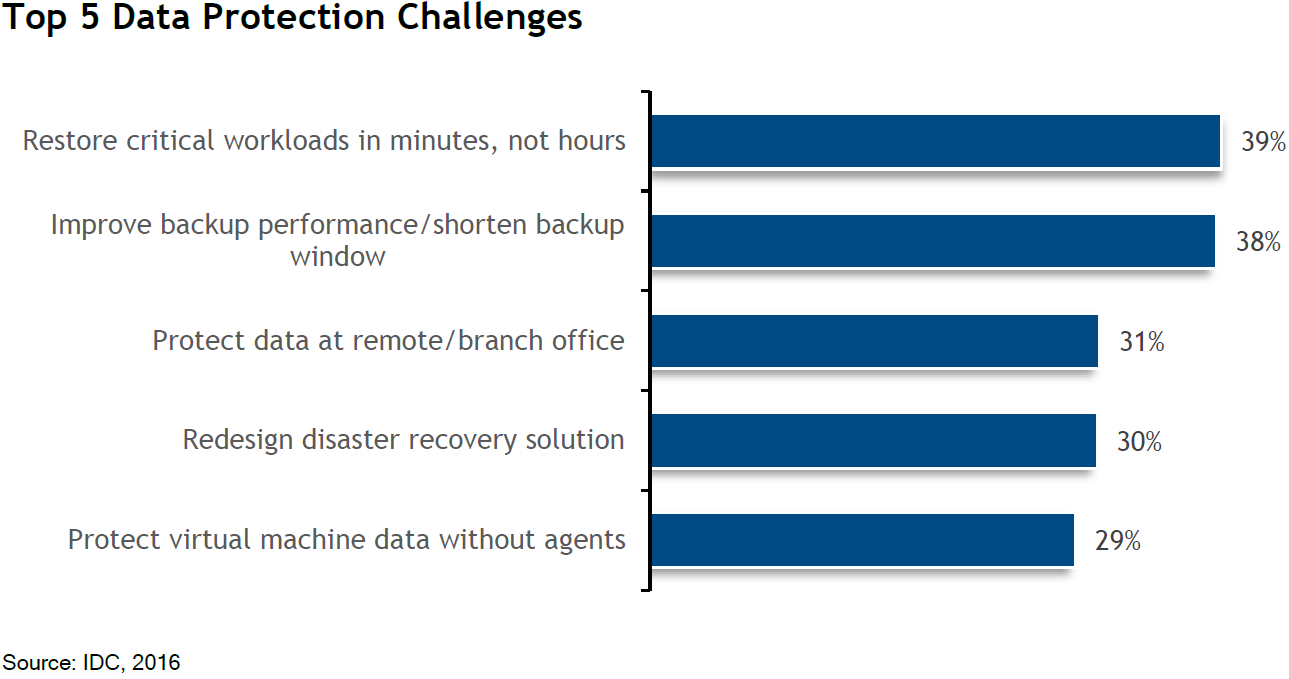It wasn’t all that long ago that data protection was pretty straightforward. You had 12+ hour backup windows to adhere to, nonexistent or “best effort” SLAs and agents galore to support your limited number of applications and operating systems. Those days are over.
IT is changing at an exponential rate. Availability 24.7.365 is now a key requirement in industries that are becoming more competitive by the day. A transformation is occurring that will require your enterprise to adopt recent technologies such as modern storage, virtualization and the cloud in order to modernize your data center – just as you’ve modernized your IT business processes. IT cost reduction is also more important than ever. Sounds easy enough, right? Wrong. There are enemies lurking in the shadows that aim to prevent you from reaching your goals:
1. Heterogeneous IT
When I started at Veeam nearly six years ago, we would have been considered an SMB. We had a few locations throughout the world and a small “server room” in each of those locations utilizing local storage and a handful of virtual machines. Today our infrastructure looks drastically different. Employing the use of networked storage, flash, hybrid cloud infrastructures, SaaS apps and other modern technologies to tackle the needs of our current enterprise-sized operation. Ensuring Availability for all of these technologies requires a fundamentally different approach to disaster recovery. What is the best way to protect these myriad systems and at the same time reduce data center costs? As your enterprise continues to grow, the questions begin to outnumber the answers.
2. Fragmentation of Data and Applications
Data, not specific technologies, are what your enterprise values most. Just as blocks of data on a hard drive can become fragmented over time, pieces of data can end up scattered across different locations and applications throughout an organization: Virtual, physical, various clouds, IaaS, SaaS, the USB hard drive in the drawer of someone’s desk…what is the best way to identify and protect this scattered data? How do you identify what is important vs what is critically important? Many modern storage technologies allow for tiering of production data –– assigning different categories of data to different types of storage in order to increase performance of critical data and reduce overall IT costs. What about applying that same strategy to your backups? Tiering backups by utilizing a combination of storage snapshots, hypervisor snapshots, nearline storage, deduplicating storage and archival storage such as tape or cloud allows you to treat the most critical asset your enterprise has –– your data –– with the importance it deserves.
3. Outdated Data Protection Tools
According to IDC, the top two data protection challenges are restoring critical workloads quickly (also known as recovery time objective or RTO) and improving backup performance (recovery point objective or RPO):
It’s simply not realistic to attempt to overcome these challenges using legacy technologies. Availability is a requirement. Not a nice-to-have, but a requirement. In fact, it is so important that Veeam has defined it as requiring recovery time and point objectives (RTPO) of less than 15 minutes for all applications and data. Legacy tools that were developed in a world where virtualization did not yet exist do not have the capabilities to achieve this demanding requirement.
4. Cost of Doing Nothing
The status quo. Standard operating procedure. If it ain’t broke, don’t fix it. Enterprises don’t always fully understand how rapidly changing today’s IT landscape is. IT managers will frequently specify acquisition costs as the largest barrier to modernizing their Availability tools. In reality, acquisition costs are usually only a small fraction of the overall issue. Operational costs, including the cost of unplanned downtime due to outdated Availability tools, can become significantly more expensive over time:
So how does an enterprise conquer these four enemies and countless others like them? First and foremost, it is important to have an understanding of the issues affecting your specific environment. Do you have an unacceptable amount of unplanned downtime? Are you measuring and achieving RTOs, RPOs, and SLAs? Do you treat backups as something that must be done rather than something that could be an asset to the organization? And, most importantly, how do you achieve all of your Availability goals in manner that reduces IT costs?
The answers are not always simple but the guidelines and recommendations in this IDC Executive Brief will move you forward in the right direction.


